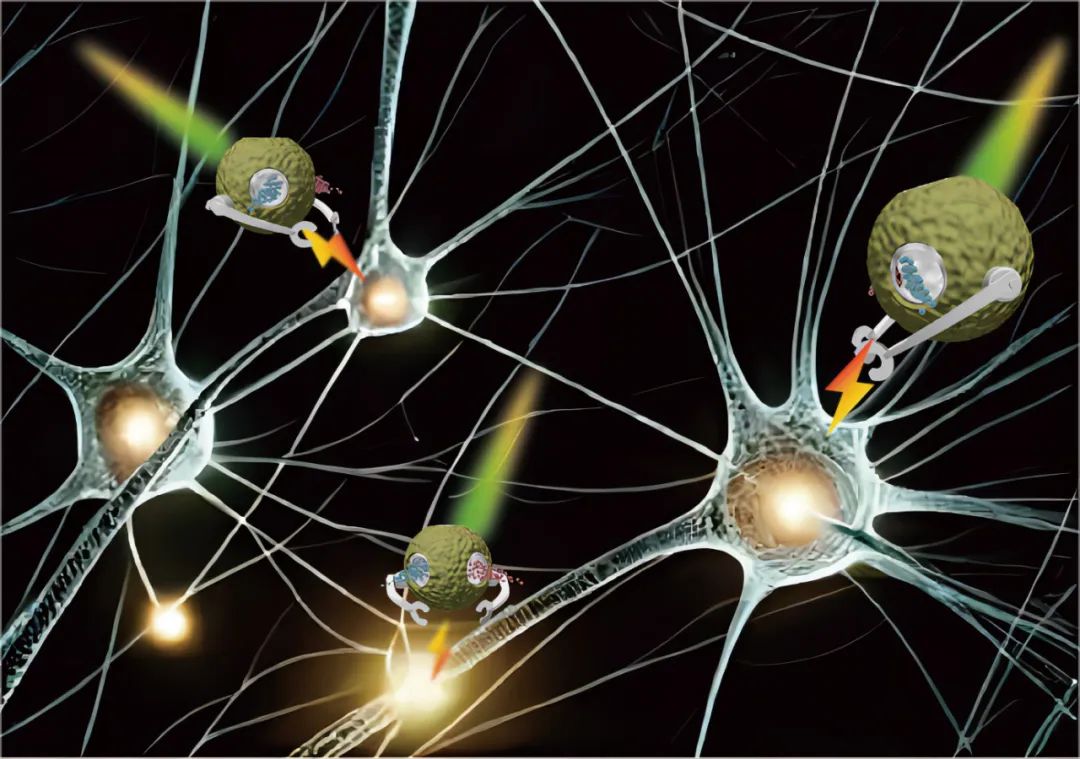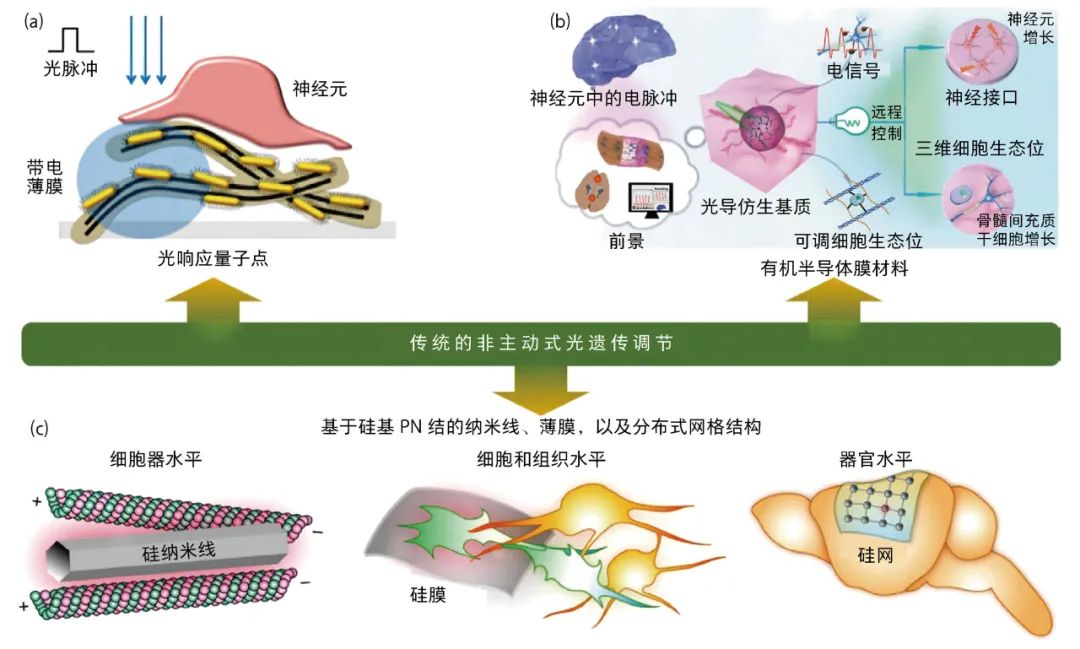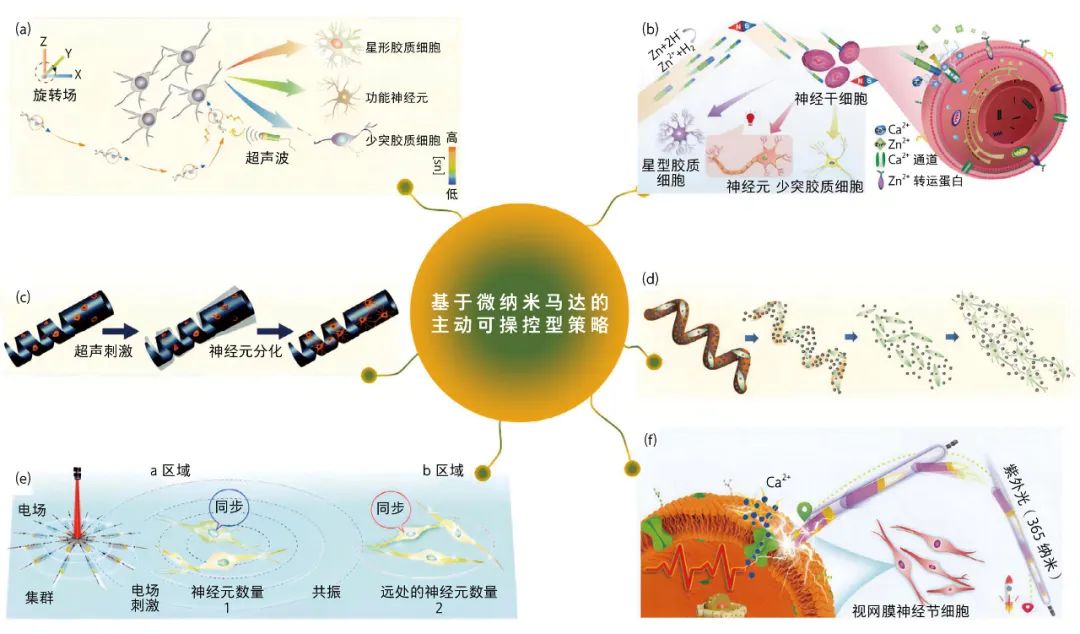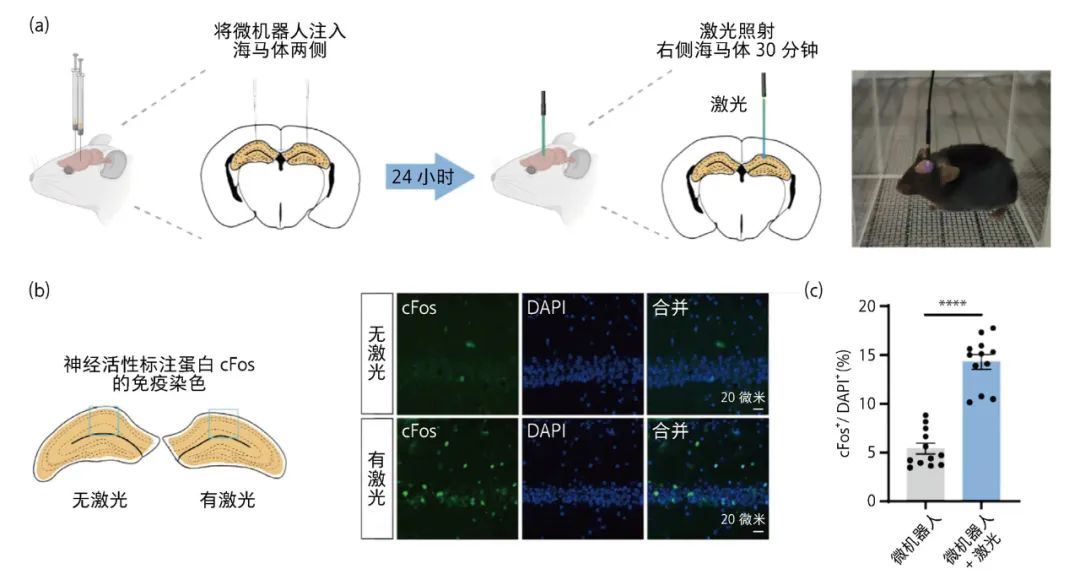Authors: Wang Jizhuang, Shi Lei, Cao Qinyi, Li Dan
The creativity of nature is breathtaking, capable of shaping intricate and intelligent life structures and forms at the micro-nano scale, such as DNA, ribosomes, bacteriophages, and Escherichia coli. In the field of engineering, scientists are striving to mimic the wonders of nature, aiming to create similar artificial intelligent agents—micro-nano robots—and are attempting to design and manufacture miniature robots that can operate and move at the microscopic scale (typically at the micron or nanometer level). These miniature robots can interact with biological entities and perform various tasks, such as targeting and treating specific cells or tissues, delivering drugs, or releasing therapeutic substances, thereby achieving more precise and efficient treatments in the medical field.

The central nervous system, composed of the brain and spinal cord, is the main part of the human nervous system, primarily responsible for transmitting, storing, and processing information, generating various mental activities, and governing and controlling all human behaviors. Neurological diseases refer to a category of diseases that affect the central nervous system or peripheral nervous system, which may lead to abnormal functions of neurons, thereby affecting the normal operation of the body. These diseases are characterized by diversity, complexity, and difficulty in treatment. Common neurological diseases include neurodegenerative diseases, such as Alzheimer’s disease and Parkinson’s disease, neurodevelopmental disorders, including autism spectrum disorders, traumatic brain injury, and mental illnesses like depression and anxiety. Neurological diseases can severely impact patients’ daily lives, careers, and social functions, making research and treatment of these diseases of great significance.
Electrical neuromodulation is an effective physical therapy method for treating neurological diseases. Many implantable medical devices based on extracellular electrical stimulation have been applied in treating diseases such as Parkinson’s disease, depression, and epilepsy. Although traditional electrode stimulation methods can significantly alleviate patients’ pain, they require external wiring for power supply in practical applications, which may cause infections in biological tissues, and traditional-sized devices struggle to achieve precise targeting at the single-cell level. Another method of neuromodulation through light is optogenetics, which provides more flexibility and resolution in control and can significantly reduce tissue inflammatory responses. However, optogenetics relies on genetic modification, which may introduce unpredictable risks or side effects in practical applications, thus raising significant controversies when applied to humans.
Recently developed non-genetic optogenetic neuromodulation technologies offer a potentially applicable approach to neuromodulation. Unlike optogenetics, non-genetic neuromodulation technologies do not require gene editing but operate by delivering photoresponsive materials to cells or tissues, generating physical and chemical signal outputs. Therefore, this method has the advantages of minimal invasiveness and high spatiotemporal precision. Currently, various light-responsive materials have been utilized for optogenetic neuromodulation, including quantum dots, gold nanoparticles, and semiconductor materials. However, achieving precise targeting control at the cellular scale still faces significant challenges, and the development of highly biocompatible light-responsive materials will greatly advance this technology.
Introduction to Micro-Nano Robots
Micro-nano robots, also known as micro-nano motors, are a new type of micro-device with specific functions that have emerged in recent years at the microscopic scale. They achieve controllable movement by converting energy from the environment, such as chemical, sound, light, electrical, magnetic, and thermal energy, into motion. With the continuous in-depth research on micro-nano motors, various micro-nano motors based on different scenarios and control methods have emerged, demonstrating excellent performance in multiple fields such as biomedicine, nano-manufacturing, and environmental remediation. In biomedicine, micro-nano motors provide a highly promising option due to their precise control characteristics, potentially achieving significant breakthroughs in real-time detection of human physiological indicators, targeted drug delivery, and non-invasive surgeries, making them a research hotspot in the field.
In recent years, with the deepening research on micro-nano robots and the refinement of applications, the requirements for their functions have also increased. Against this backdrop, the coupling of multiple signals in composite micro-nano motors has become an effective design strategy and a current research focus. The concept of composite micro-nano robots mainly couples multiple functions and control methods to achieve functional goals that are difficult to achieve through a single driving method. Among them, magnetic-controlled motors, as one of the most mature and highest precision control methods, have shown great potential in medical applications when combined with feedback imaging technology. Therefore, fully leveraging the precise control of magnetic motors, combined with the application needs of non-genetic optogenetic neuromodulation, constructing a light-magnetic composite micro-nano motor system using efficient optoelectronic conversion materials is expected to provide an effective solution for achieving targeted light neuromodulation at the cellular level, as well as offer new possibilities for independent neuron stimulation control and revealing the mechanisms of their interactions.
Non-Genetic Optogenetic Neuromodulation
Currently, the research strategies for non-genetic optogenetic neuromodulation can be divided into two categories: traditional non-active strategies and actively controllable strategies. Traditional non-active methods mainly adjust through the use of photoresponsive materials or devices, but they have limited precision and may easily interfere with surrounding neurons and cause a certain degree of invasiveness. In contrast, actively controllable strategies aim to use external wireless control to deliver responsive materials to the target cell location, achieving high precision and minimal invasiveness, showing excellent research and application potential.
In actively controllable strategies, the application of micro-nano robots in neuromodulation is receiving wide attention. Compared to traditional methods, the active controllability of micro-nano robots provides researchers with more flexible and precise tools to accurately deliver responsive materials to specific neuron locations, thereby achieving high precision in neuromodulation, which is expected to bring significant breakthroughs in the field of neuroscience. However, given that this technology is still in the developmental stage, further in-depth research and validation of its feasibility are needed to gain a more comprehensive understanding of its potential applications in neuromodulation.
Non-Active Optogenetic Neuromodulation Strategies
Traditional non-active modulation strategies mainly utilize photoresponsive materials, such as quantum dots, gold nanoparticles, semiconductor materials, or devices, to conduct research on non-genetic optical stimulation neuromodulation by co-cultivating with neurons or attaching to tissues and organs. For example, light excitation of CdSe quantum dot-modified carbon nanotube biomimetic functional membranes can effectively activate retinal neurons[1]. Additionally, organic semiconductor membrane materials and devices have shown good stimulation activation effects on cultured neural networks and retinal neurons[2].
Silicon-based semiconductor materials are also a more mature material system for non-genetic optogenetic neuromodulation research. Professor Tian Bozhi from the University of Chicago has made outstanding contributions in this field[3]. Silicon-based nanomaterials have the advantages of good biocompatibility, controllable optoelectronic properties, a wide light absorption range, and ease of device fabrication. The team systematically studied the effects of silicon-based PN junction solar cells’ single nanowire, thin films, and distributed grid structures on light stimulation neuromodulation at the organelle, cellular, and tissue levels. Due to their efficient optoelectronic conversion performance, silicon-based materials show unique advantages in non-genetic optogenetic neuromodulation. These studies indicate that non-genetic optogenetic neuromodulation based on optoelectronic conversion materials has tremendous developmental potential. Furthermore, enhancing stimulation patterns based on bulk materials, thin films, or randomly distributed nanomaterials to achieve higher non-invasiveness and stimulation precision will benefit deeper biological mechanism research.

Three Typical Traditional Non-Active Optogenetic Neuromodulation Strategies (a) CdSe quantum dot-modified carbon nanotube biomimetic functional membrane light stimulation activates retinal neurons; (b) organic semiconductor thin films used for light stimulation of neural cell behavior research schematic; (c) single nanowires, thin films, and distributed grid structures based on silicon-based PN junction solar cells for light stimulation neuromodulation at the organelle, cellular, tissue, and organ levels schematic.
Micro-Nano Robot Neuromodulation Strategies
To improve stimulation precision and reduce invasiveness issues, actively controllable strategies developed in conjunction with micro-nano robot technology are expected to provide new approaches for non-genetic neuromodulation. Currently, research on micro-nano robots in neuromodulation is still in its infancy, primarily utilizing composite micro-nano robot systems coupling piezoelectric, soft magnetic, magnetoelectric, and optoelectronic conversion materials. In 2021, researchers achieved targeted neuron ultrasound stimulation directional differentiation by coupling magnetic-controlled helical motors with ultrasound piezoelectric material BaTiO3 nanoparticles[4]. The team also produced micro-robots made of Ni-Zn materials that generate self-built electric fields causing the opening of Ca2+ channels, increasing Ca2+ influx, thus inducing neural stem cell differentiation[5]. Additionally, using laser ablation technology, they developed magnetic-controlled composite micro-nano motors based on soft piezoelectric polymer helical structures, where the rotating magnetic field control enables cellular transportation and directional differentiation of neurons under ultrasound piezoelectric stimulation[6]. A soft hydrogel helical structure motor was developed through two-photon 3D printing, which, when doped with magnetoelectric nanoparticles, can also achieve cellular stimulation differentiation[7].
In light stimulation neuromodulation, Professors Tu Yingfeng and Peng Fei designed a highly controllable nanorobot cluster driven by near-infrared light in 2023. Under near-infrared light irradiation, the nanorobot cluster exhibits periodic chemical-electric field and reversible contraction-expansion-contraction (oscillation) behavior, activating the local retinal ganglion cells through the oscillation generated by the cluster[8]. Furthermore, the team developed TiO2-Au nanowire motors, which can be driven and controlled by ultraviolet light from different incident directions, while effectively achieving targeted light stimulation activation of retinal neurons through the photogenerated optoelectronic signals[9]. This research provides an excellent reference for targeted light stimulation neuromodulation based on micro-nano motors.
Therefore, developing efficient optoelectronic materials that can be excited by visible light and coupling flexible control methods can greatly enhance their applicability. Fully exploring the advantages of non-genetic optogenetic neuromodulation, combined with the characteristics of micro-nano motors, to develop composite micro-nano motor systems with precise controllability and efficient optoelectronic conversion performance can provide new means for targeted light neuromodulation at the single-cell precision level, and also offer feasibility for more in-depth biological mechanism research.

Active Controllable Strategies Based on Micro-Nano Motors (a) Magnetic-controlled helical motors coupled with ultrasound piezoelectric material BaTiO3 nanoparticles achieve targeted neuron ultrasound stimulation directional differentiation; (b) pure water-driven nickel-zinc micro-nano motors generate self-built electric fields that can activate cellular signaling pathways, inducing neural stem cell directional differentiation; (c) magnetic-controlled composite micro-nano motors can achieve directional differentiation of neural cells under ultrasound piezoelectric stimulation; (d) soft hydrogel helical structure motors developed through two-photon 3D printing, doped with magnetoelectric materials, can achieve cellular stimulation differentiation under magnetic field stimulation; (e) under near-infrared light irradiation, nanorobot clusters generate oscillations to activate local retinal ganglion cells; (f) TiO2-Au nanowire motors driven and controlled by ultraviolet light from different incident directions effectively achieve targeted light stimulation activation of retinal neurons.
Magnetic-Controlled Composite Micro-Robots
In 2023, my team successfully developed a magnetic-controlled composite micro-robot (MOHR) based on silicon nanowire solar cell structures[10]. MOHR possesses the ability to achieve precise magnetic control through rotating magnetic fields, while the silicon-based solar cell structure can efficiently provide optoelectronic stimulation signals, thus achieving non-genetic optogenetic neuromodulation under visible light excitation. Through therapeutic experiments on constructed Alzheimer’s disease (AD) neuron models, research results indicate that this micro-robot can significantly promote the functional recovery of neurons in AD pathology and demonstrate excellent neuronal activation effects in vivo.
Targeted Light Neuromodulation
The design of the light-magnetic composite micro-robot (MOHR) is based on a silicon nanowire metal-insulator-semiconductor (MIS) structure. By optimizing the MIS structure and reasonably selecting magnetic metals as the metal ends, it also serves as a magnetic control component, providing the possibility for precise magnetic control of MOHR. Additionally, its efficient optoelectronic conversion capability can provide sufficient stimulation signals for neuromodulation.

Light-Magnetic Composite Micro-Robot Targeted Light Neuromodulation
Multi-Mode Magnetic Control of Composite Micro-Robots
Utilizing programmable three-dimensional Helmholtz coils can achieve precise magnetic control of MOHR. The nanorod structure of MOHR can preset magnetization directions to obtain multi-mode drives, including axial rolling, radial rolling, and swinging, with different movement modes allowing MOHR to adapt to different biological environments. MOHR demonstrates excellent magnetic driving performance under all three movement modes and can also achieve precise path operation through preset programs, proving its control accuracy.

Multi-Mode Magnetic Control of MOHR
Single and Collective Control of MOHR in Biological Environments and In Situ Light Stimulation for Neuronal Repair
The manipulation capabilities of MOHR in actual biological environments lay the foundation for its application. Through movement tests in cellular environments and different biological fluids, MOHR not only demonstrates good mobility in various liquid environments (such as PBS, artificial cerebrospinal fluid, and blood) but also shows minimal influence from different liquid environments. Additionally, MOHR can precisely target specific neurons and exhibit resistance against blood flow in flowing blood environments.
In experiments simulating AD neurons, researchers constructed an AD pathogenic factor β-amyloid peptide Aβ42 oligomer-damaged hippocampal neuron model and injected increasing currents into the neurons before and after MOHR stimulation. The results showed that the discharge frequency of Aβ42 damaged neurons decreased; however, after these damaged neurons were activated by laser irradiation, their excitability was restored. Furthermore, researchers found that the excitability of normal neurons internalizing MOHR was unaffected by laser irradiation, indicating that MOHR not only does not affect the basic excitability of healthy neurons but can also reactivate damaged neurons. This series of experiments demonstrates the outstanding performance of MOHR in complex biological environments, establishing a solid foundation for its wide application in neuromodulation.

Single Control of MOHR in Biological Environments and In Situ Light Stimulation for Neuronal Repair
Micro-Robot Photoacoustic Imaging Control and In Vivo Activation of Hippocampal Neurons
Photoacoustic imaging, as a high-precision, non-invasive imaging method, is extremely suitable for guiding micro-nano robots in biological bodies. To verify the effects of composite micro-robots on the nervous system in vivo, researchers injected MOHR clusters into the hippocampal region of C57BL/6 mice through brain stereotactic injection. After 24 hours of internalization, laser irradiation for 30 minutes significantly activated hippocampal neurons, and the expression of the neuronal activity marker protein cFos significantly increased. To evaluate whether MOHR could trigger an immune response, researchers measured the expression levels of inflammatory factors in the hippocampal region 24 hours after MOHR treatment. The results indicated that levels of interleukin (IL)-1β, IL-6, and tumor necrosis factor (TNF)-α did not significantly increase after MOHR injection. This series of experimental results demonstrates that MOHR has broad application potential in activating neuronal cells in the brain.

MOHR Photoacoustic Imaging Control and In Vivo Activation of Hippocampal Neurons
In summary, this composite micro-robot possesses precise magnetic targeting control capabilities, inducing rapid increases in intracellular calcium concentrations and leading to cell membrane depolarization through coupled optoelectronic stimulation. These characteristics enable MOHR to restore the excitability of AD-like (Aβ42-damaged) neurons. Additionally, in vivo experiments in mice demonstrate that MOHR can trigger significant neuronal activity without causing severe immune side effects. This micro-nano robot technology exhibits exceptional potential in precise targeted non-genetic optogenetic neuromodulation, capable of in situ modulating the required cell populations, enhancing cell excitability, and promoting the functional recovery of neurons in AD pathology. It shows good neuronal activation effects in vivo, providing a reliable tool for in-depth research on neuronal modulation and related mechanisms.
Conclusion
With the vigorous development of micro-nano technology, micro-nano robots are gradually revealing their outstanding application potential in various fields. We firmly believe that as research continues to deepen, micro-nano robots will play an increasingly critical role in the precise regulation and study of the nervous system, with their more precise signal stimulation delivery capabilities expected to promote the development of brain science in neuromodulation research. Researchers can achieve targeted manipulation of neural circuits by introducing micro-nano robots into specific brain regions, thereby deeply studying the interactions and information transmission mechanisms between different brain regions, providing unprecedented research tools for understanding complex brain functions such as cognition, emotion, and movement.
Moreover, the application of micro-nano robots in neuromodulation research will assist in the treatment of neurological diseases. Through their precise neuromodulation functions, they provide new avenues for the treatment of neurological diseases, allowing for more direct and precise intervention in abnormal neural activities, thus alleviating patients’ symptoms.
Overall, the prospects for micro-nano robots in neuromodulation research are promising. Continuous innovations in this field will help expand our understanding of neuroscience and provide more advanced and personalized medical solutions for human health.
Wang Jizhuang, Associate Professor; Cao Qinyi, Master Degree Candidate; Li Dan, Professor: College of Chemistry and Materials Science, Guangdong Provincial Key Laboratory of Functional Supramolecular Coordination Materials and Applications, Jinan University, Guangzhou 510632. [email protected]
Shi Lei, Professor: State Key Laboratory of Bioactive Molecules and Druggability Assessment, JNU-HKUST Joint Laboratory for Neuroscience and Innovative Drug Research, Jinan University, Guangzhou 510632.
Wang Jizhuang, Associate Professor; Cao Qinyi, Master Degree Candidate; Li Dan, Professor: College of Chemistry and Materials Science, Guangdong Provincial Key Laboratory of Functional Supramolecular Coordination Materials and Applications, Jinan University, Guangzhou 510632.
Shi Lei, Professor: State Key Laboratory of Bioactive Molecules and Druggability Assessment, JNU-HKUST Joint Laboratory for Neuroscience and Innovative Drug Research, Jinan University, Guangzhou 510632.
[1]Wu C, Pu Y, Zhang Y, et al. A bioactive and photoresponsive platform for wireless electrical stimulation to promote neurogenesis. Advanced Healthcare Materials, 2022, 11 (20): 2201255.
[2]Fang Y, Jiang Y, Acaron L H, et al. Texturing silicon nanowires for highly localized optical modulation of cellular dynamics. Nano Letters, 2018, 18 (7): 4487-4492.
[3]Rotenberg M Y, Tian B. Talking to cells: Semiconductor nanomaterials at the cellular Interface. Advanced Biosystems, 2018, 2 (4): 1700242.
[4]Liu L, Wu J, Wang S, et al. Control the neural stem cell fate with biohybrid piezoelectrical magnetite micromotors. Nano Letters, 2021, 21 (8): 3518-3526.
[5]Feng Y, Gao C, Xie D, et al. Directed neural stem cells differentiation via signal communication with Ni–Zn micromotors. Advanced Materials, 2023, 35 (35): 2301736.
[6]Chen X Z, Liu J H, Dong M, et al. Magnetically driven piezoelectric soft microswimmers for neuron-like cell delivery and neuronal differentiation. Materials Horizons, 2019, 6 (7): 1512-1516.
[7]Dong M, Wang X, Chen X Z, et al. 3D-printed soft magnetoelectric microswimmers for delivery and differentiation of neuron-like cells. Advanced Functional Materials, 2020, 30 (17): 1910323.
[8]Chen B, Tan H, Ding M, et al. Nanorobot-mediated synchronized neuron activation. ACS Nano, 2023, 17 (14): 13826-13839.
[9]Chen B, Liu L, Liu K, et al. Photoelectrochemical TiO2-Au-nanowire-based motor for precise modulation of single-neuron activities. Advanced Functional Materials, 2021, 31 (10): 2008667.
[10]Gao Y, Guo Y, Yang Y, et al. Magnetically manipulated optoelectronic hybrid microrobots for optically targeted non-genetic neuromodulation. Advanced Materials, 2023, 36(8): 2305632.
Keywords: Light-Magnetic Composite Micro-Robots, Magnetic Targeted Control, Optoelectronic Conversion, Non-Genetic Optogenetic Neuromodulation■

Chinese Society of Biotechnology Science Popularization Account
Follow our news
Delivering highly valuable scientific knowledge to you

